Russian Federation
Abstract: Reactive arthritis (Rea) belongs to the group of seronegative spondyloarthritis (Spa) and is often associated with the carrier of HLA-B27-antigen, which, together with the presence of a distant focus of infection,increases the risk of developing arthritis. The most common causes of reactive arthritis are latent urogenital infections and acute intestinal infections. diagnosis of Rhea is difficult due to the similarity of the clinical picture with other diseases of the musculoskeletal system that occur with joint damage, as well as, often, the absence of an obvious connection between the joint syndrome and pre-existing infection. If the diagnosis is correct, it is necessary to identify the pathogen and prescribe etiotropic therapy, but even in this case, recovery does not occur in 100% of cases. Approximately 20% of patients may have chronic disease, so it is necessary to first pay more attention to the detection of infections-triggers and treat them at an early stage.
reactive arthritis, chlamydia, enterocolitis, macrolides, tetracyclines, fluoroquinolones
1. Nasonov EL, Nasonova VA, red. Revmatologiya. Nacional'noe rukovodstvo. M.: GEOTAR-Media; 2017. 720 s
2. Belov BS, Shubin SV, Balabanova RM, Erdes ShF. Reaktivnye artrity. Nauchno-prakticheskaya revmatologiya. 2015;53(4):414-420.
3. Asner TV, Kalyagin AN. Urogennye reaktivnye artrity: sovremennye aspekty diagnostiki i lecheniya. Sovremennaya revmatologiya. 2010; №4: 11-15.
4. Glazunov AV, Panina IA, Adzhigaytkanova SK, Glazunov PA. Reaktivnye artrity: kriterii diagnoza i podhody k etiotropnoy terapii. Klinicheskaya gerontologiya. 2008; №2:41-46.
5. Kazakova TV, Rashid MA, Shostak NA, Karpova NYu. Reaktivnyy artrit: klinika, diagnostika, lechenie. Lechebnoe delo. 1.2010: 11-22.








